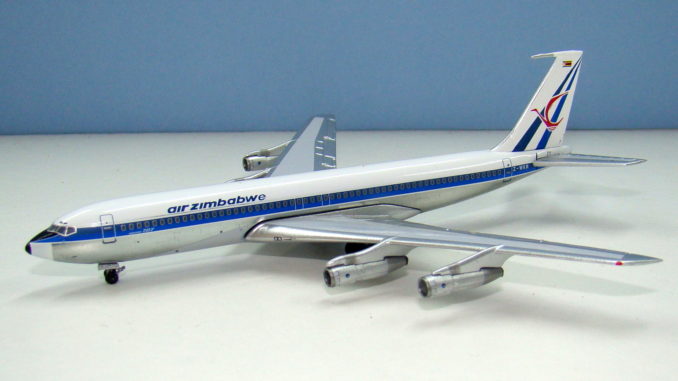
This model is rather timely to say the least. Not only has the collectorate been awaiting a release from Zimbabwe for many years but only a few weeks after its release the African nation is once again in the news. I started writing this review before the coup against the country’s Mugabe dictatorship and it remains to be seen what will transpire. Even so Aeroclassics 707s are always welcome and hopefully the appearance of this model is a harbinger of good news for the nation.
THE REAL THING
Nowadays it is hard to find anything positive to say about Zimbabwe following Robert Mugabe’s increasingly tyrannical rule since he became President in 1987. Mind you he was no shrinking violet beforehand when Prime Minister, being in direct command of the notorious North Korean trained Fifth Brigade responsible for massacring thousands of civilians during the 5 year Gukurahundi that saw possibly up to 80,000 killed. Using his anti-imperialist (and basically racist anti-white) credentials he has avoided condemnation from fellow African leaders and been able to transform Zimbabwe into an embarrassing shambolic destitute nation racked by hyper-inflation and widespread human rights violations.
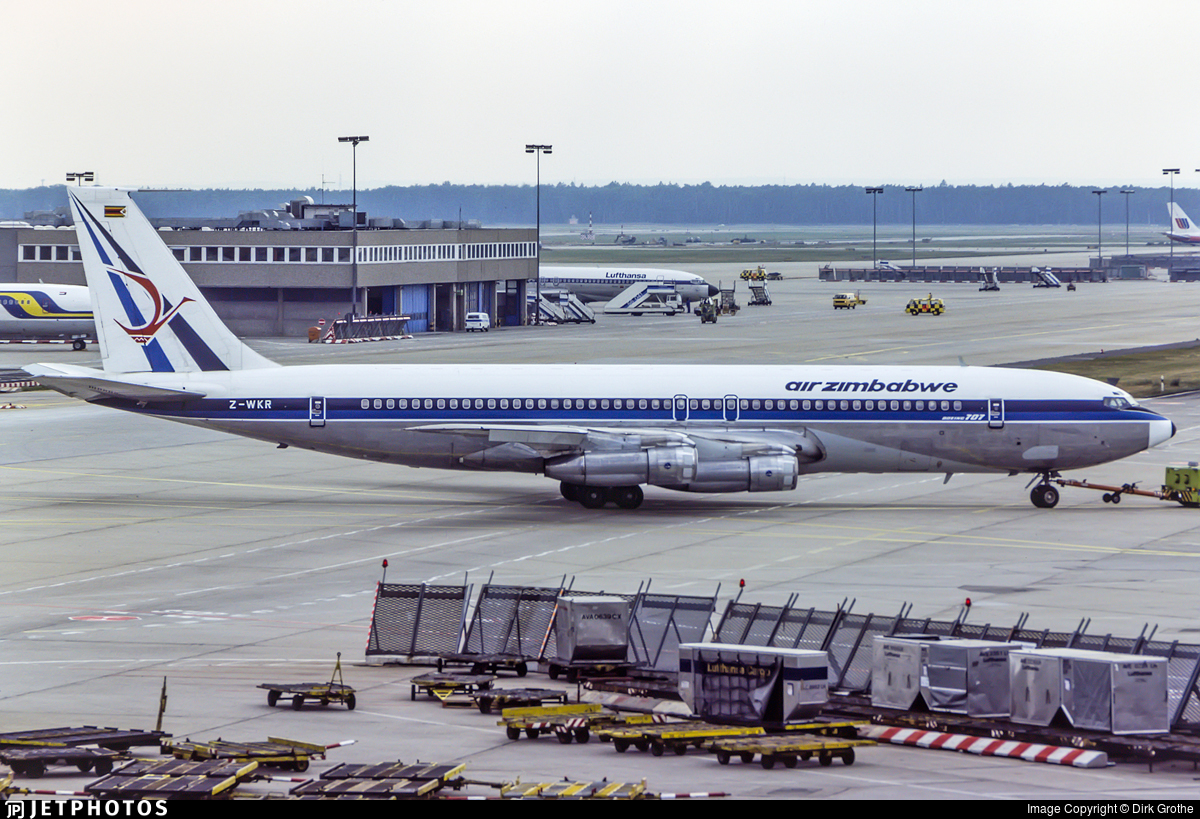
The national airline has accordingly suffered along with the rest of the country and has lurched from crisis to crisis with an aging and barely maintainable fleet. Bizarre orders for equipment like Ilyushin IL-96s have unsurprisingly not come to fruition. It wasn’t always like this and I recall during the 1980 and early 90s regularly seeing Air Zimbabwe 707s and 767-200s visiting London Gatwick.
Zimbabwe only came into being as an independent internationally recognised nation in 1980. This was following a protracted civil war since the 1965 unilateral declaration of independence of Rhodesia that turned it into a pariah state. Air Zimbabwe was formed from the renamed Air Rhodesia, which had successfully acquired and operated jets through less than legal means. The fleet was ‘renewed’ of sorts by leasing a pair of 707s until 5 more could be acquired from Lufthansa.
These were all 707-330Bs of which the 1964 build D-ABOX, ‘Koln’, became VP-WKR in February 1981 and then Z-WKR in October 1983. The 707s were supplemented by a pair of brand new 767-200ER flagships from 1989 but continued to ply international destinations well into the 1990s. Z-WKR was however sold at around the time of the 767’s service entry in August 1990. She joined Seagreen/African International Airways in August 1990 as 5Y-AXM and her remaining career seems to have included several periods of storage. She was finally abandoned at Nairobi in November 1996 and broken up at Nairobi around June 2001.
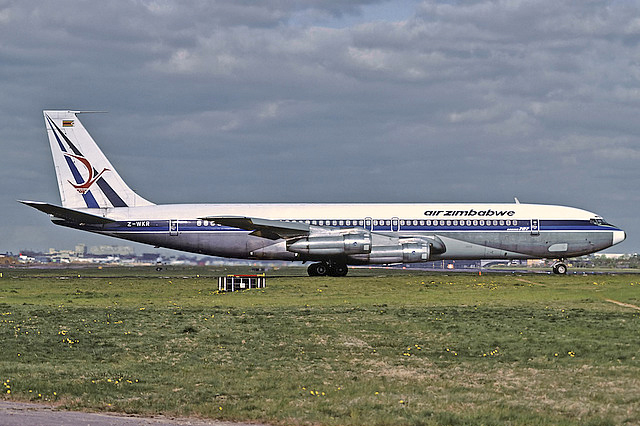
Air Zimbabwe has struggled earnestly onwards into the present and been forced to cease operations more than once. The current fleet theoretically includes a pair of 737-200s and single examples of the 767-200, A320 and Xian MA60 although how many of these are active it is hard to say. As recently as April the entire 5 aircraft Air Zimbabwe fleet was declared non-airworthy whilst the airline has debts of well over USD $300 million.
Until last week it seemed that with Robert Mugabe positioning his wife as his successor, and hyperinflation again rampant, that the instability that has plagued Zimbabwe for decades was unlikely to end anytime soon. However earlier this week the military has undertaken a coup of sorts. Given they and the main man behind it, Vice President Emmerson Mnangagwa, are almost as complicit as Mugabe in the country’s failing state it is unclear whether the removal of Mugabe is a positive change or not. Hopefully it will be and the rehabilitation of Zimbabwean institutions like Air Zimbabwe can begin and return ‘hospitality in the skies’ as its slogan promises.
THE MODEL
The format for my reviews is to split them into three key areas:
- The mould of the aircraft
- The paint and livery
- Printing and quality control
Each can get a maximum score of 10 for a section giving a maximum combined total score of 30.
THE MOULD
Aeroclassics modern first generation jet moulds are universally excellent. Their Boeing 707, like their Douglas DC-8, is one of the finest moulds in 1:400. It technically depicts a Boeing 707-320B Advanced or Boeing 707-320C rather than an earlier 707-320/420 or 320B. In 1:400 scale you can tell this as it has no ventral fin and more modern rectangular style nosegear doors as well as the modified wing – the latter feature being the only one of the three shared with the standard 707-320B.
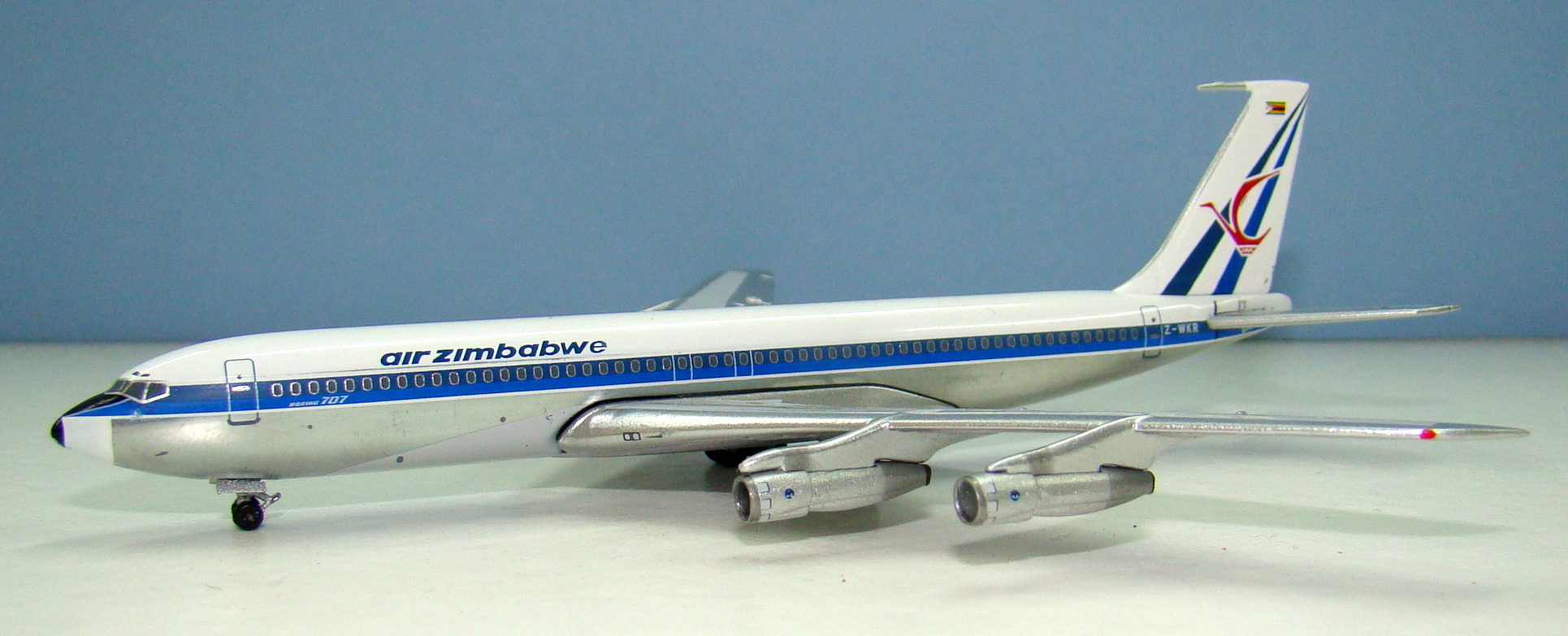
Impressively this mould actually dates all the way back to 2003 although it was updated in 2007 with rolling gears. The only slight negative on an otherwise almost perfect mould, is the cradle mount and therefore wing seam. It does follow the general flow of the real things wing join fairing but is still a bit obvious. Interestingly Witty Wings copied the mould in 2008 to make a seamless version.
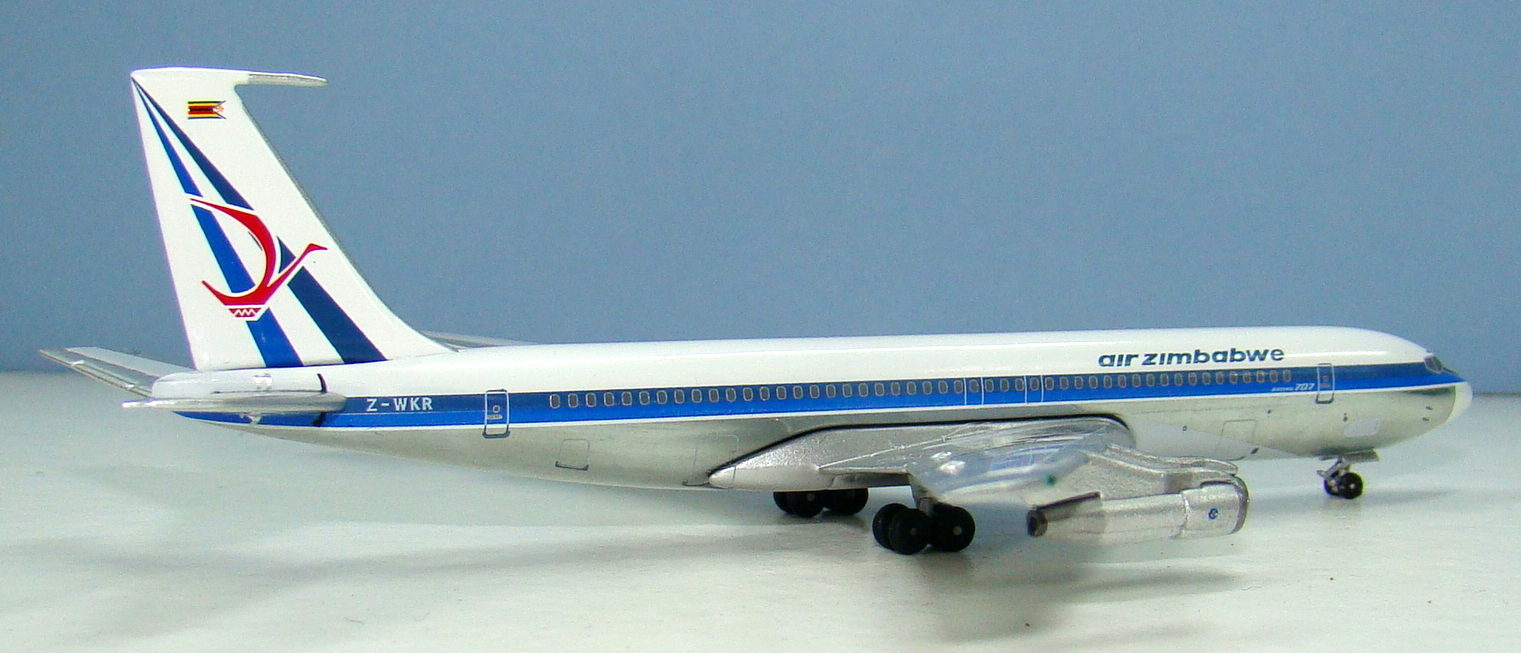
I’m not entirely sure the rolling gears are an improvement either since the nosegear tyre is probably a little too small. Nonetheless it is gratifying that such a good mould is available for such an important type. I only wish that Aeroclassics would see to it that the earlier versions of the 707 also had such a good mould.
SCORE – 9
PAINT & LIVERY
Initially Air Zimbabwe simply accepted the already fleet wide livery of Air Rhodesia with simple title changes and that is the livery depicted on this model release as opposed to the extremely colourful national colours livery introduced in 1982. The Air Rhodesia scheme was attractive and unusually for an African airline based around blue. A classic two tone blue cheatline ran along the fuselage with triangular blue and white striping on the tail. Superimposed over the tail markings was the airlines logo in red. Known as the ‘twiggi bird’ it was a highly stylized representation of the Zimbabwe bird.
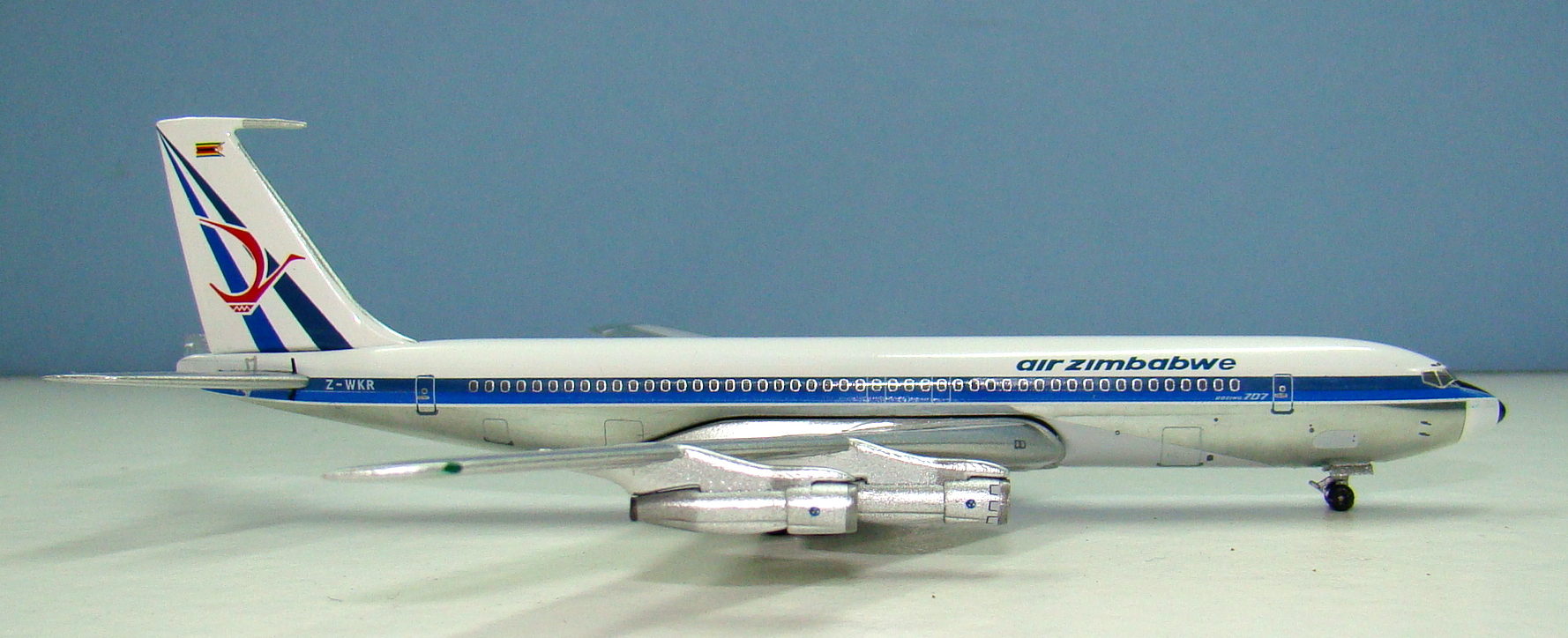
Air Zimbabwe altered the scheme by replacing the original capitalized straight ‘AIR RHODESIA’ titles with italicized lowercase ‘air zimbabwe’ ones and replacing the national flag on the tail. This aircraft was still wearing the old colours well into mid-1984.
Aeroclassics have successfully reproduced the twin blue colours of the scheme although perhaps the darker stripe could be darker than it is. The red colour of the bird logo is also fine and the national flag correctly positioned on the tail. Indeed the entire tail and cheatline are well represented as is the white nosecone and Boeing 707 titles inside the cheatlines.
It is a shame given the rest of the scheme that Aeroclassics has once again fallen short with the titling. They have admittedly tried hard to get it correct but failed at the last. The font used is particularly unusual with the lower case i letters not being dotted and the w being oddly asymmetrical even given the slanting font.
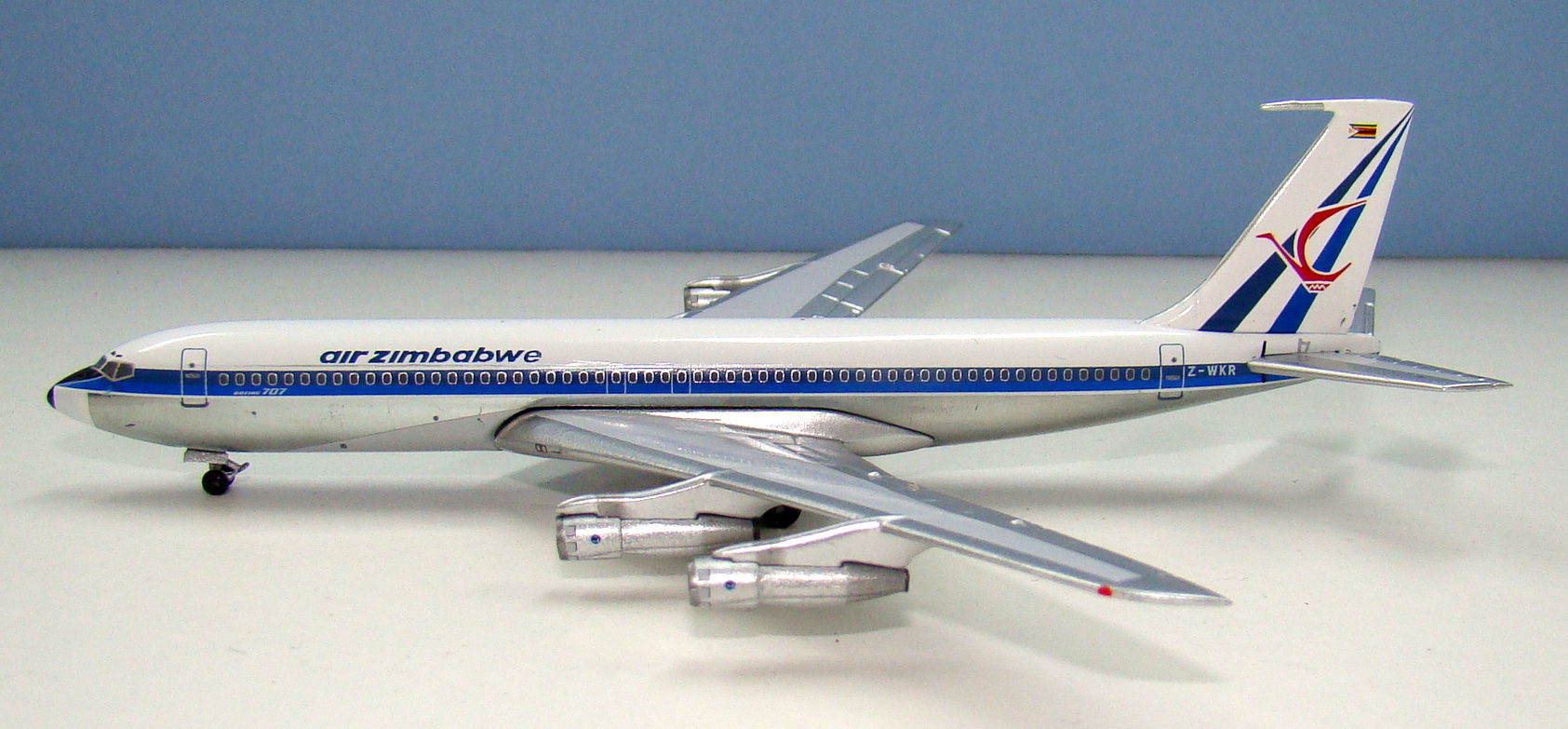
Aeroclassics has actually got the font correct however the last e of Zimbabwe is peculiar. It is worst on the port side of the model being unusually feint and a little too distant from the w. On the starboard side this is much less noticeable. Actually it isn’t the only issue on the port side but I’ll cover the other one in the printing section. Overall the livery has been well created but the e does detract somewhat from the total look.
SCORE – 8
PRINTING & QUALITY CONTROL
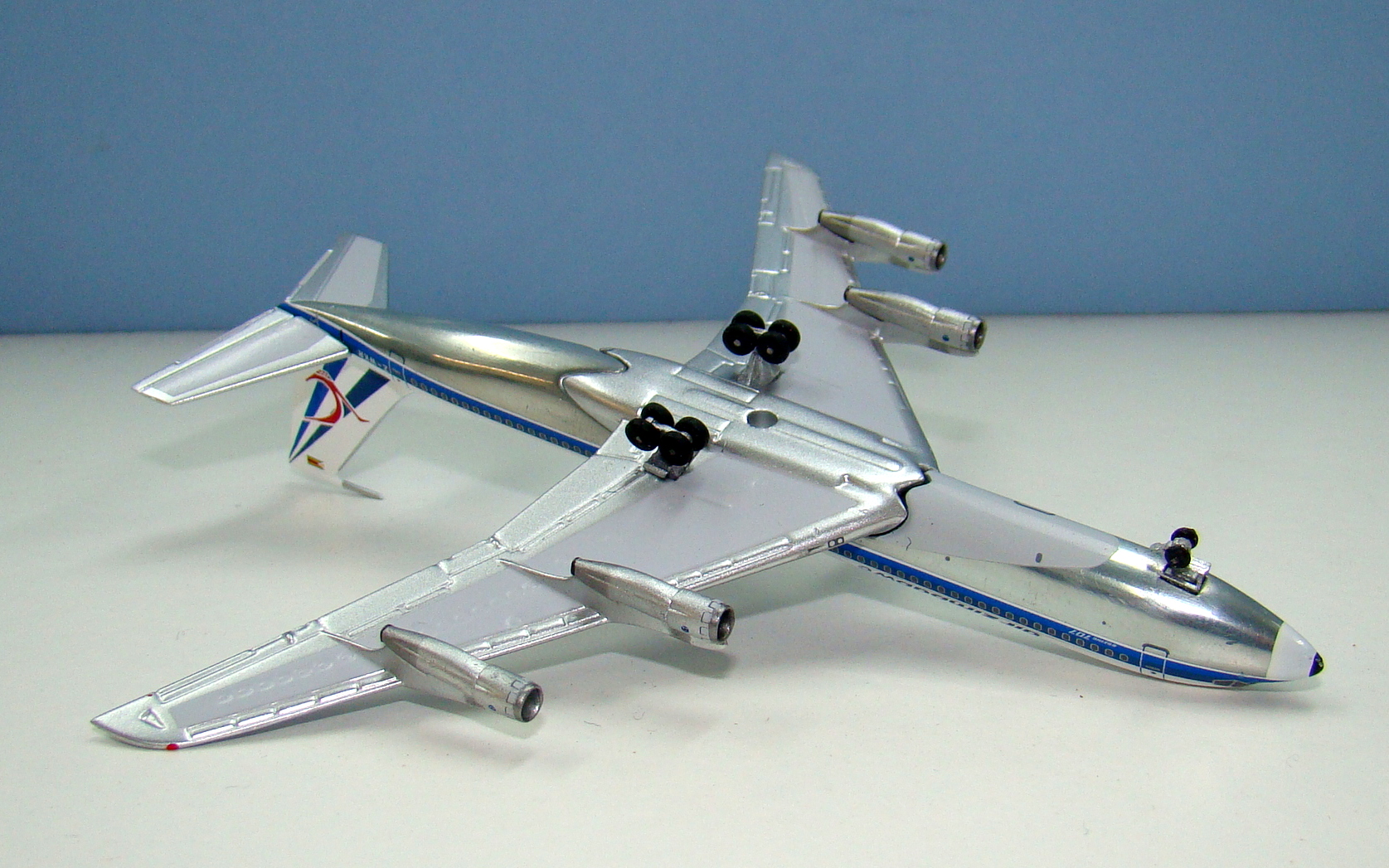
Aeroclassics are usually fairly reliable on the printing front but have shown worrying slip ups at various times. Unfortunately this model is not immune to this. I’ve already discussed the faded e but on the same port side under the titles there is also a blue line running for most of the length of the forward fuselage ahead of the wing. It shouldn’t be there and indeed isn’t on the starboard side. The rest of the printing is good although it’s worth mentioning that the engine fanblades are disappointingly silvery.
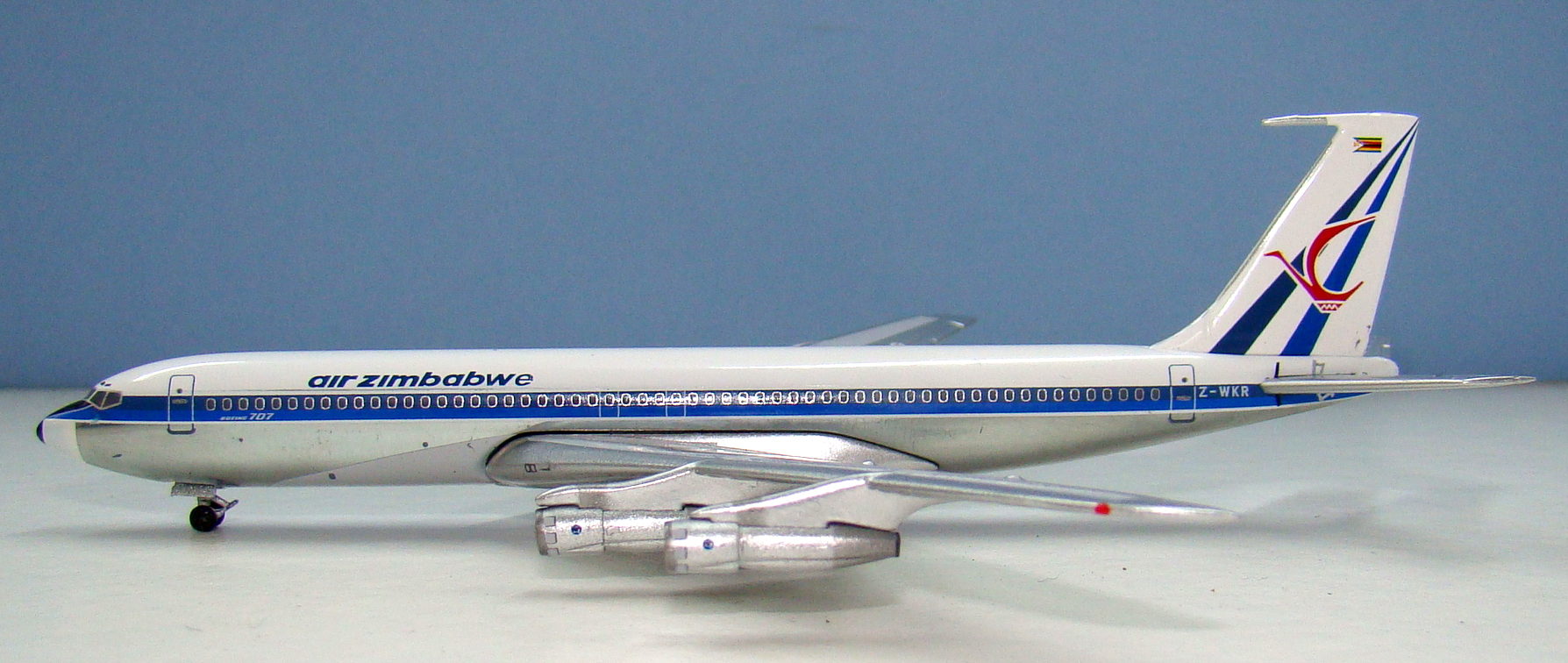
Likewise construction problems are usually the reserve of the other manufacturers and not Aeroclassics but this model shows an annoying level of laziness here as well. The wing seam on the Aeroclassics 707 doesn’t bother me however on this model it is larger than it ought to be as the wings are poorly fitted to the fuselage. In fact if you hold the model up and look through the seam you can see clear through to the other side of the aircraft. The fit is worst at the front. It is not an issue on my other 707s, including the Air Malta example that arrived with this one, so I must put it down to poor finishing.
SCORE – 7
CONCLUSION
I am keen on collecting aircraft from as many nations as possible and I rely on Aeroclassics to produce a wide range of interesting airlines. This is something they do very well. Usually they can be relied on to also finish the models well but this Air Zimbabwe 707, although a fine model, suffers from some frustrating detail deficiencies that should be easily avoidable. As such it loses points that should rightfully be its and despite being on one of the best moulds gets merely a standard pass mark rather than a top grade.
FINAL SCORE – 24/30


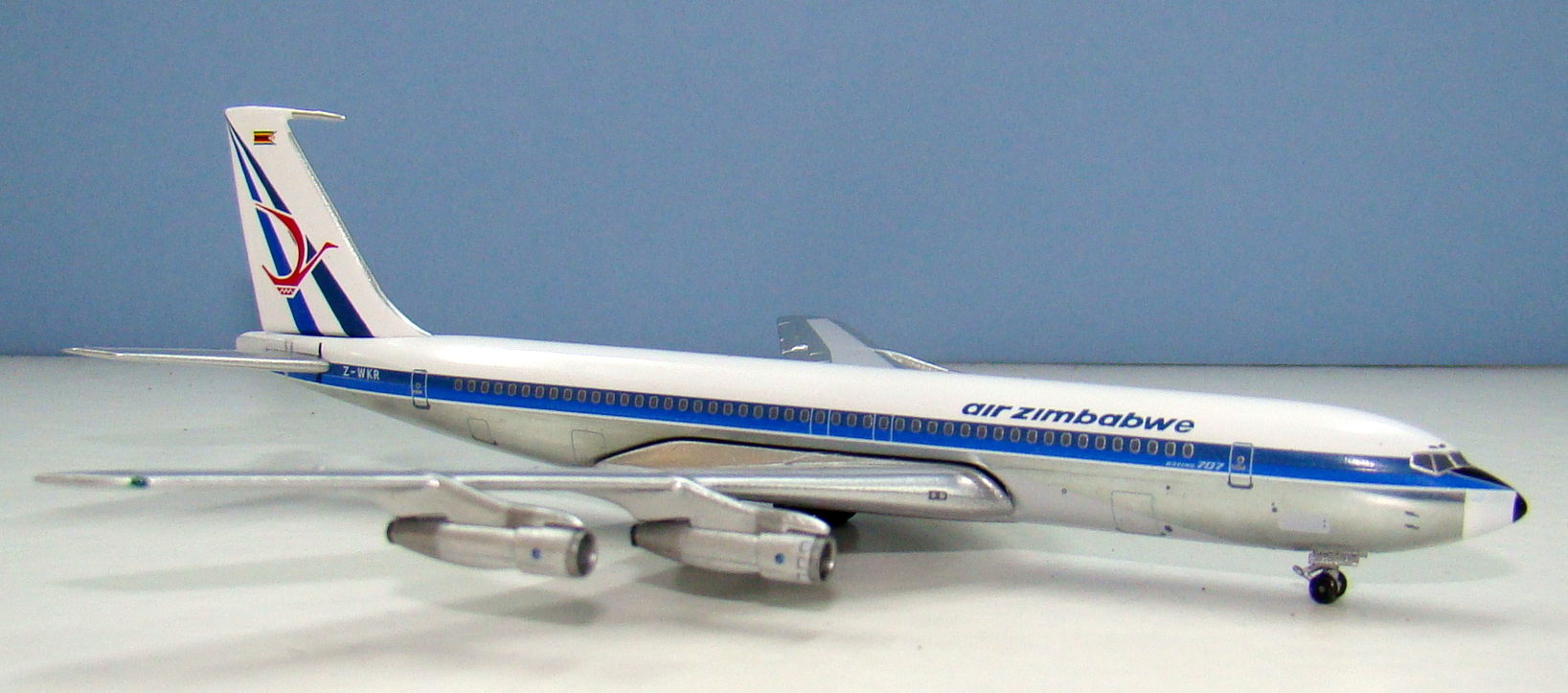
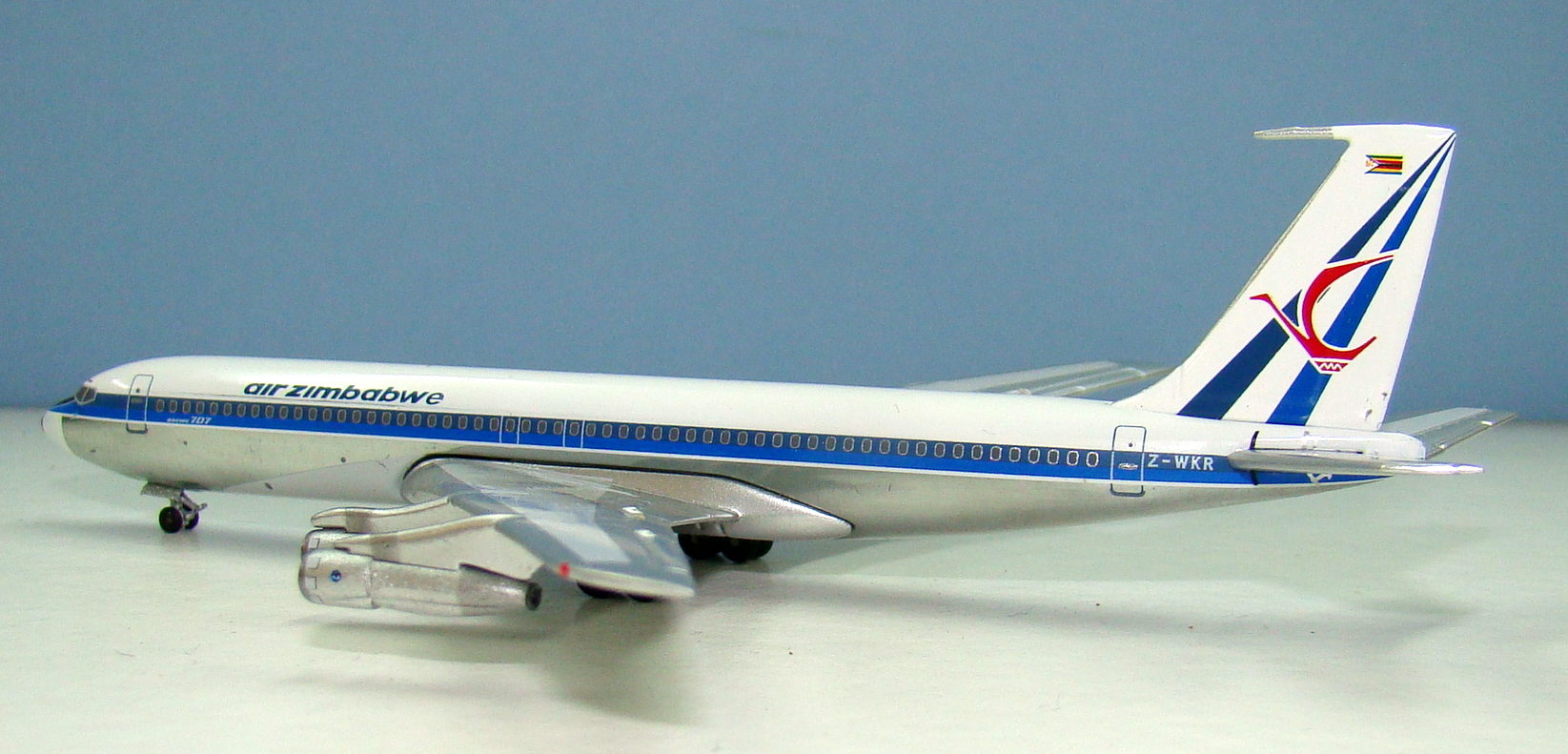
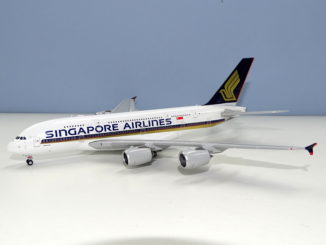


Excellent objective review – as always – Richard.
Hopefully the wing seam issue was peculiar to this particular model only and others may find theirs are a good fit.
I have bent all of my AeroClassics’ 707 HF antennas back up to straight by just placing my thumb under them and applying some gentle pressure. Have never broken one.
Pity about the blue line under the titles – perhaps a bit of “bleed” that, once again, may be peculiar to this sample only and may not be present on all models. Hopefully!
I would have liked to see your review also cover the wing finish – particularly the painting of the inspar which, as I have stated elsewhere, is incorrect for a Boeing. Boeing applied a “Coroguard” finish to the wing inspars and AeroClassics have rendered this silvery/grey finish very accurately on previous 707 releases (e.g. their QANTAS 707-338C). The lighter grey on the inspars of this AZ model looks more like what Douglas used on their DC-8s, -9s, -10s etc. It is a shame AeroClassics messed this up, especially as they have done it so well on past releases.
Excellent review Richard and good additional comments by Gavin above.
I did comment on the inconsistent title font lettering on 400SH, but of course any criticism gets deleted by AK, so glad it’s mentioned here for all to read.
Thanks Richard for a good in depth study, made me pull my example out of the display case for inspection under a magnifying glass. Happily mine has a good wing/fuselage seam, very tight, and the printing is correct except for the undotted “I”…seems you got a bum example there…first off the line?